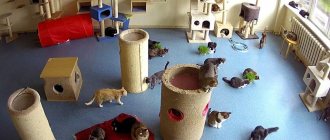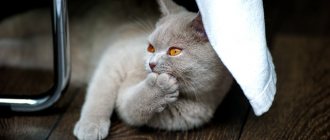Veterinarian tips for feeding cats
Veterinarian tips for caring for cats:
- Cats need to be fed meat, but not very fatty, dairy products. Meat should be given to cats raw, at least every other day, after scalding the piece with boiling water. With raw meat, cats receive the bioflavonoids necessary for their predatory body, which are needed for metabolic processes. Without raw meat, cats may get sick and lose their fur.
- These animals are big lovers of meat, such as: chicken, beef, veal, minced meat, chicken gizzards and necks and liver. All this can be fed to cats. Veterinarians recommend giving liver to cats 1-2 times a week, after pouring boiling water over it.
- If you feed your cat liver very often, it can lead to hypervitaminosis (excess of vitamins) A and D vitamins.
- Also, cereals and vegetables are very useful for cats, but not every cat will eat it. Therefore, study your pet to see which cereal or vegetable does not disgust him, and mix it into his food.
- If you managed to teach your cat to eat cereals and vegetables, then this is only a plus. You can cook different porridges, except for rolled oats (it contributes to disruption of carbohydrate metabolism in cats).
- You can also add vegetables to the porridge, both boiled and raw, simply grated. Raw vegetables, like raw meat, are also very necessary for the cat's body. Beans, tomatoes and eggplants are contraindicated for cats. Vegetables can be served with meat, without cereals.
- also needs to take special vitamins , they can be in the form of tablets, or place a pot of special grass next to the bowls, which contains all the vitamins necessary for cats.
- Be sure to remember to provide fresh, clean water .
- Cats can be given only 1-2 eggs per week, no more, as this destroys biotin, which is responsible for the health of the coat. Lack of biotin leads to hair loss.
- Nowadays, on store shelves we are offered a large assortment of dry ready-made cat food, but not all of them are healthy. Veterinarians recommend choosing food at a high or medium price; it contains a large percentage of meat and all the substances and vitamins necessary for the health of cats.
- Cheaper food does not contain meat at all; instead of animal protein, it uses vegetable soy protein, which can cause stones in cats.
Healthy nutrition is good for cats too.
How to prepare an apartment for a new tenant?
According to the fair view of most owners, the ability to use a litter box and the absence of the habit of sharpening its claws on furniture are skills that are absolutely necessary for a cat to live in an apartment. It would be stupid, however, to demand appropriate behavior from a very young animal that has just been taken into the house. That is why, before placing a kitten in your home, the living space should be properly prepared.
Indoor plants are removed from the room where the baby will be kept so that the smell of the soil does not cause the pet the wrong “toilet” associations. For the same purpose, furniture in the room is moved so as not to leave secluded corners for the kitten where he could defecate and urinate while no one sees him.
It would be a good idea to remove easily breakable objects from the premises so that the growing animal does not damage the owner’s property during its active games. Things can also be put away in closets, but then it is worth putting child protection on their doors in advance so that an interested cat cannot open them under any circumstances.
What should you not feed your cat? What do veterinarians advise not to give to cats?
Not everything can be fed to a cat; many foods are very dangerous. Let's look at the list of these products.
Veterinarian tips for caring for cats:
- Many people think that fish is a cat's favorite treat, but this is not true. Fish is harmful to them; it contains a lot of protein, which increases the load on the animal’s kidneys, thereby destroying the mineral balance, after which urolithiasis begins.
- Feeding cats only fish will cause a deficiency of vitamin K, which will lead to poor blood clotting. In addition, the fish may be infected with parasites. Therefore, if you decide to pamper your pet with fish, choose sea fish and feed it once a week, maximum twice.
- You should not give cats flour products and legumes, they cause flatulence in the animal and intestinal upset.
- You can't feed cats pork; it's too fatty for them. Fatty foods cause obesity of internal organs in cats, and pork meat can also contain parasites.
- You also shouldn’t let the food you give your cat have any seasonings.
- Make sure that cats do not get to indoor plants, as they can be poisonous.
Veterinarians advise not to feed cats everything.
Cat food
Cat bowl photo can be enlarged
You can feed your cat professional or semi-professional food, but feeding it food from your table is strictly prohibited. The fact is that not all human foods are suitable for the animal’s body. A completely different matter...small birds and rodents. In nature, cats eat them every day. However, since we don’t have a predator living in our house, but a completely civilized domestic cat, we will replace rodents and birds with... meat, offal and grains - this is what a caught mouse or bird “consists” of. Therefore, if you decide to prepare your cat’s food yourself, diversify its diet with cereals with boiled meat and vegetables, low-fat dairy products, eggs, and boiled fish.
If you don’t have the time and opportunity to come up with something new every day for your pet’s menu, or the cat is not too willing to eat the dishes you prepare, you can switch it to ready-made food. True, I would like to say right away - do not skimp on the cost of such feed. Cheap canned food has a “cheap” composition (waste and soy), therefore, such food is unlikely to contribute to cat health and longevity. In addition, expensive food is more filling, and the portion can be reduced a little if you are worried about saving money.
While the animal is a kitten, it needs to be fed 5-6 times a day, every 2-3 hours. The portions should not be too large, and it is better to remove any leftover food so that you can offer the kitten fresh food at the next feeding. The older the kitten gets, the longer the intervals between feedings become, the portion sizes increase and the frequency of feedings decreases. The teenage kitten no longer eats at night and eats 3-4 times a day. When the cat turns one year old, you can, with a clear conscience, transfer it to 2-3 meals a day.
photo can be enlarged
Some cat owners prefer to measure portion sizes almost using home scales, and some are guided by the principle “the portion should be such that the cat eats it without leaving a trace.” In principle, the latter option is more correct, the main thing is not to overfeed the animal. Therefore, just take note of how much your cat eats at a time and try to give her exactly that much food. As a hint, you can conditionally divide the container with food several times and try to maintain the sizes of such portions.
If the cat does not leave its plate after eating and continues to look into your eyes, the animal is most likely not full, you will have to give it a supplement and in the future reconsider the amount of food you give to the cat. And, a sign that the animal is full will be its contented purring and ritual washing. All cats are clean cats, so after eating they always wash themselves.
Don't forget that in addition to eating, your cat also drinks. Therefore, she should always have clean and fresh water in a special bowl, which you will change regularly, not forgetting to wash the water bowl itself.
How to accustom a cat to a new home: advice from a veterinarian
Veterinarian tips for caring for cats:
- If you cannot imagine life without a pet and decide to get yourself a pet, then veterinarians advise adopting an animal at the age of 10-12 weeks. At this age, the pet begins to get used to the person.
- When you bring your furry pet into your home, the bag or basket in which the animal was brought does not need to be removed immediately. Place it in a corner until the cat adapts to the new place, it will be a refuge for it, the cat will use it more than once. Place the necessary vessels in a place visible to your pet - a bowl for food and water, a tray where the cat will go to the toilet.
- Food bowls should be made of materials that are easy to clean, and the litter tray should be spacious, 5-10 centimeters high. For convenience, the bottom of the tray can be filled with special granules - fillers, sawdust or torn paper. This kind of filler is easy to replace, but it’s better not to use sand; throwing it down the toilet can clog the pipes in your house.
- With the advent of a new home, the cat may behave very warily, hide in a corner or, on the contrary, sniff everything. At such a moment, the animal experiences great stress; a person must help the pet survive this stage. At such a moment, the person himself should be calm, not scream, not behave aggressively while the pet gets used to the new place.
- Try to spend a few days as much time as possible with the new family member, pay more attention to him and then the adaptation period will end much faster.
For a cat to be happy, you just need to love it.
How to care for a cat: basic hygiene rules
If you want to see your cat healthy and beautiful, you need not only to create good conditions for keeping it (a comfortable place to sleep, a litter tray, rational feeding), but also to provide it with proper care. What do I mean by cat care? You must:
- take care of the fur;
- examine and clean teeth and gums;
- check and clean your nose and ears if necessary;
- will take care of the claws.
How to care for a cat's fur
As for grooming, a sensible future owner should think about this even at the stage of choosing a breed. If you like long-haired cats, weigh it a hundred times: can you properly care for the beauty’s fur? This is very important, because without care, the fur of such cats gets matted, and cleaning the house will take much more time.
However, even short-haired cats, such as British or Abyssinian, need to be combed, but this work will not take much time, and nothing bad will happen if you skip this procedure once or twice.
But these animals themselves take care of the cleanliness of their body by constantly licking those parts of the body that they can reach. The cat's tongue is rough, and she licks a lot of fur, which ends up in the stomach. If the dead hairs are not combed out, the cat will often vomit balls of hair. However, if she doesn’t vomit hair too often, there’s nothing wrong with that.
The combing procedure rids our pets of dandruff and dirt. If you suddenly notice black lumps on the fur that look like dirt, most likely your cat has fleas. I talked about where they come from in pets and how to deal with them in the article “Fleas on cats: how to get rid of them.”
As you know, the main problem of cat lovers is the ubiquitous fur, which they jokingly call “seasoning.”











